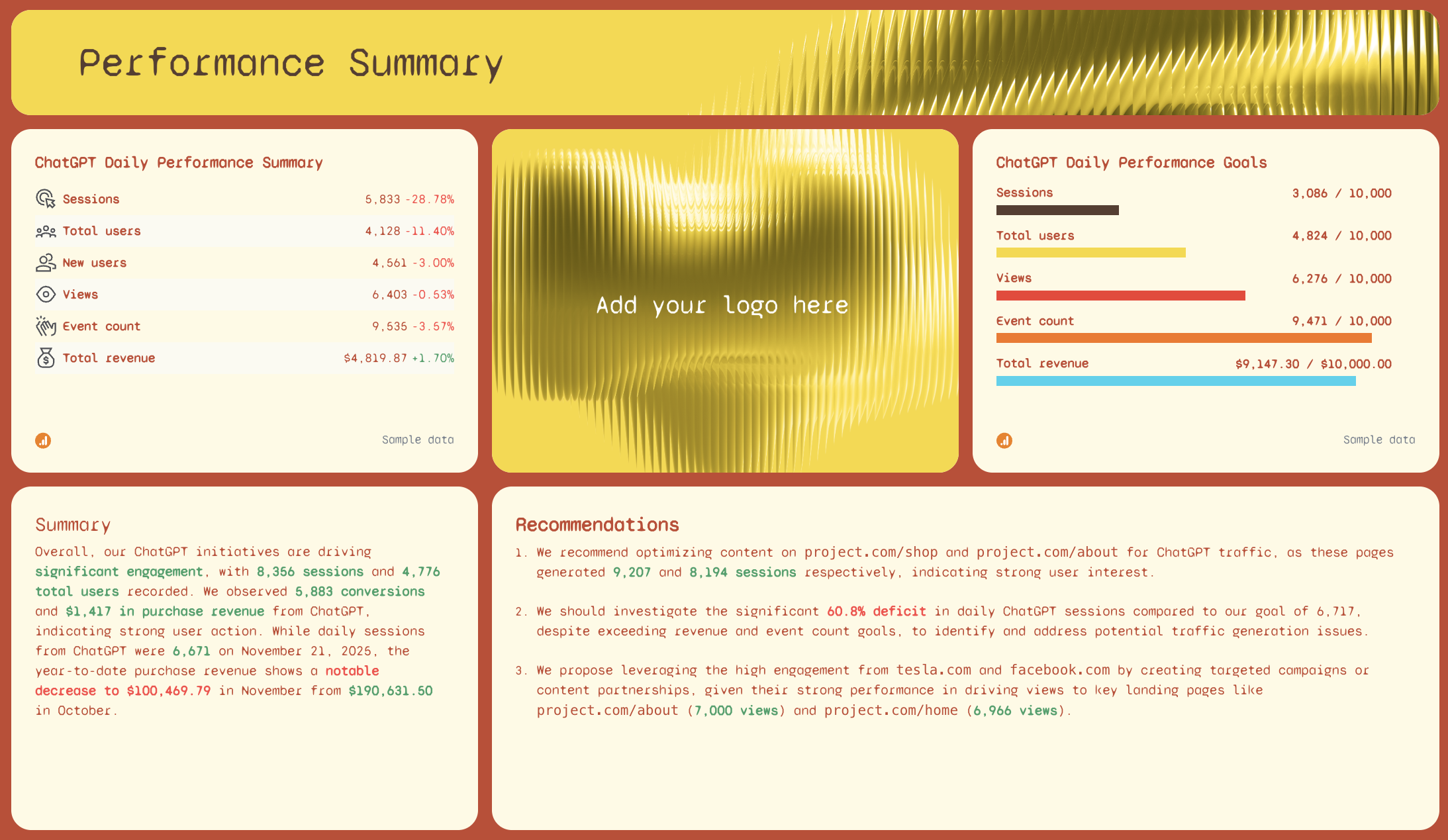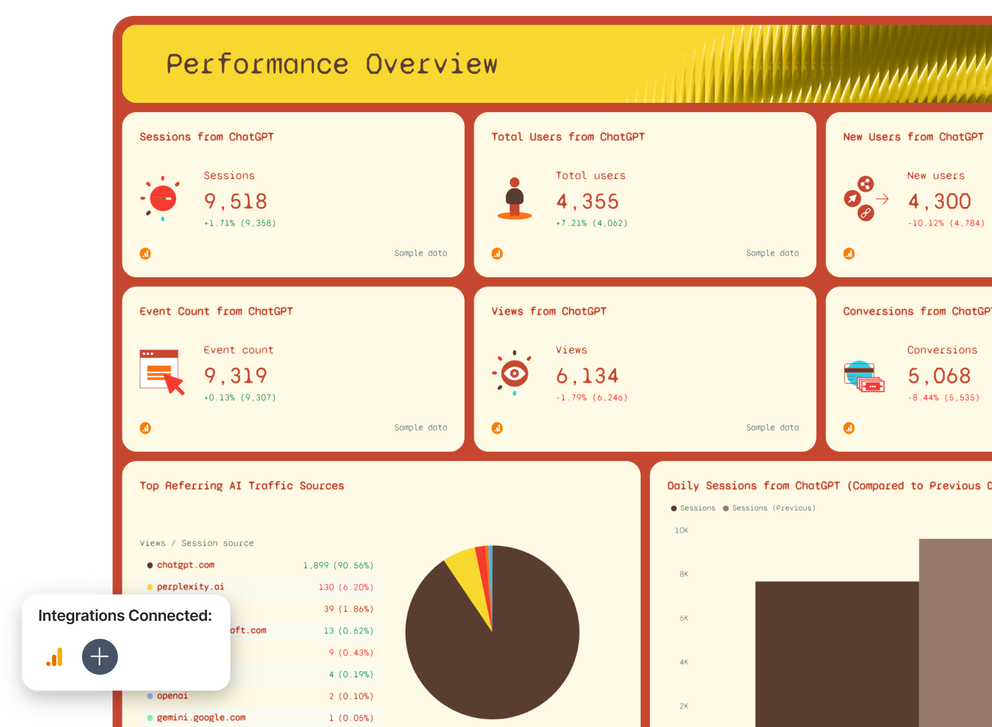What To Include in a ChatGPT Daily Report Template
A ChatGPT daily report helps you understand how much website traffic, engagement, and revenue you generated today, and how that compares to yesterday.
It’s built for fast decision-making, giving marketers and SEO teams a simple snapshot of key metrics without digging through dashboards or exporting Excel files.
Below is everything your daily performance report should include, based on the real templates used by teams tracking ChatGPT and OpenAI traffic every day.
1. Performance Summary
 This is the first thing stakeholders expect to see—your “big picture” daily view in one place.
This is the first thing stakeholders expect to see—your “big picture” daily view in one place.
Your Performance Summary should include:
- A daily performance report widget showing today’s sessions, total users, new users, views, event count, and revenue from ChatGPT.
- A comparison column showing how each metric moved versus yesterday (+/- %).
- A goals progress widget showing how close you are to your daily KPIs—helpful for daily standups, quick follow-up conversations, and internal workflow reviews.
- A text section for summaries and actionable insights.
With Whatagraph IQ, you can just ask AI to write performance summaries based on your data to save you time. It’s available in 18 languages and 5 different formats—Summary, Recommendations, Wins, Issues, or custom prompt.
There’s no hallucinations because it’s based on your actual connected data, and you don’t have to worry about data breaches either because the data stays on Whatagraph.
Whatagraph comes with some strong security measures like ISO27001, GDPR compliance, AES-256 encryption, EU data hosting and SSO/SAML.
2. Performance Overview

This section breaks down today’s performance into simple widgets and trend graphs, helping you understand how users from ChatGPT behave day-to-day.
It should include:
- Individual widgets for sessions, total users, new users, views, conversions, and event count from ChatGPT only.
- Data filtered in the backend using GA4 + a custom condition:
Source / Medium → matches regex → chatgpt | openai - A daily bar graph comparing today vs. yesterday sessions.
- A trend line visualizing daily patterns for the past few days.
- A pie chart of Top Referring AI Traffic Sources (Tesla.com, ChatGPT, Instagram, Google.com, Apple.com, etc.).
Important: Although this is a daily report, the “Top Referring AI Traffic Sources” pie chart uses a monthly dataset. Traffic sources don’t meaningfully shift every 24 hours, so the monthly dataset provides more reliable insights for marketers, SEO specialists, and anyone reviewing daily patterns.
3. eCommerce Overview

This section is ideal for online stores tracking revenue influenced by ChatGPT and similar AI tools.
Your eCommerce section should include:
- Today’s ecommerce purchases, average purchase revenue, and total purchase revenue from ChatGPT.
- A year-to-date line graph showing ecommerce purchases from ChatGPT.
- A year-to-date bar graph showing revenue trends from ChatGPT.
Why year-to-date though? Because ecommerce performance is too noisy to analyze “just for today.” Daily-only numbers make patterns hard to spot, so year-to-date datasets reveal real trends that help you optimize future campaigns.
4. Session Breakdown

This section breaks down your website traffic by ChatGPT and other AI-driven sources.
Include two tables:
a. Session Breakdown by AI Source (Today vs. Yesterday)
Shows:
- Views
- Sessions
- Total users
- New users
- Event count
…across traffic sources like ChatGPT, WhataGraph.com, Tesla.com, Google.com, Facebook.com, etc.
b. Session Breakdown by URL (Today vs. Yesterday)
This table shows where AI users actually land.
It helps teams understand:
- Which landing pages get the most AI-driven activity
- Where engagement is dropping
- Where to improve marketing campaigns, content, or UX
These tables are extremely helpful for real-time troubleshooting without digging through raw datasets or time-consuming spreadsheets.
5. ChatGPT vs. Google

The final section compares ChatGPT-driven traffic with Google and other classic search sources in a clean side-by-side layout.
Include:
- Sessions
- Total users
- New users
- Views
- Event count
The goal is to see:
- Is ChatGPT gaining ground on search?
- Is it influencing your workflow or SEO priorities?
- When should you optimize content for AI-driven discovery instead of traditional search engines?
This comparison helps stakeholders make confident, data-driven takeaways for your next daily standup or follow-up review.



















